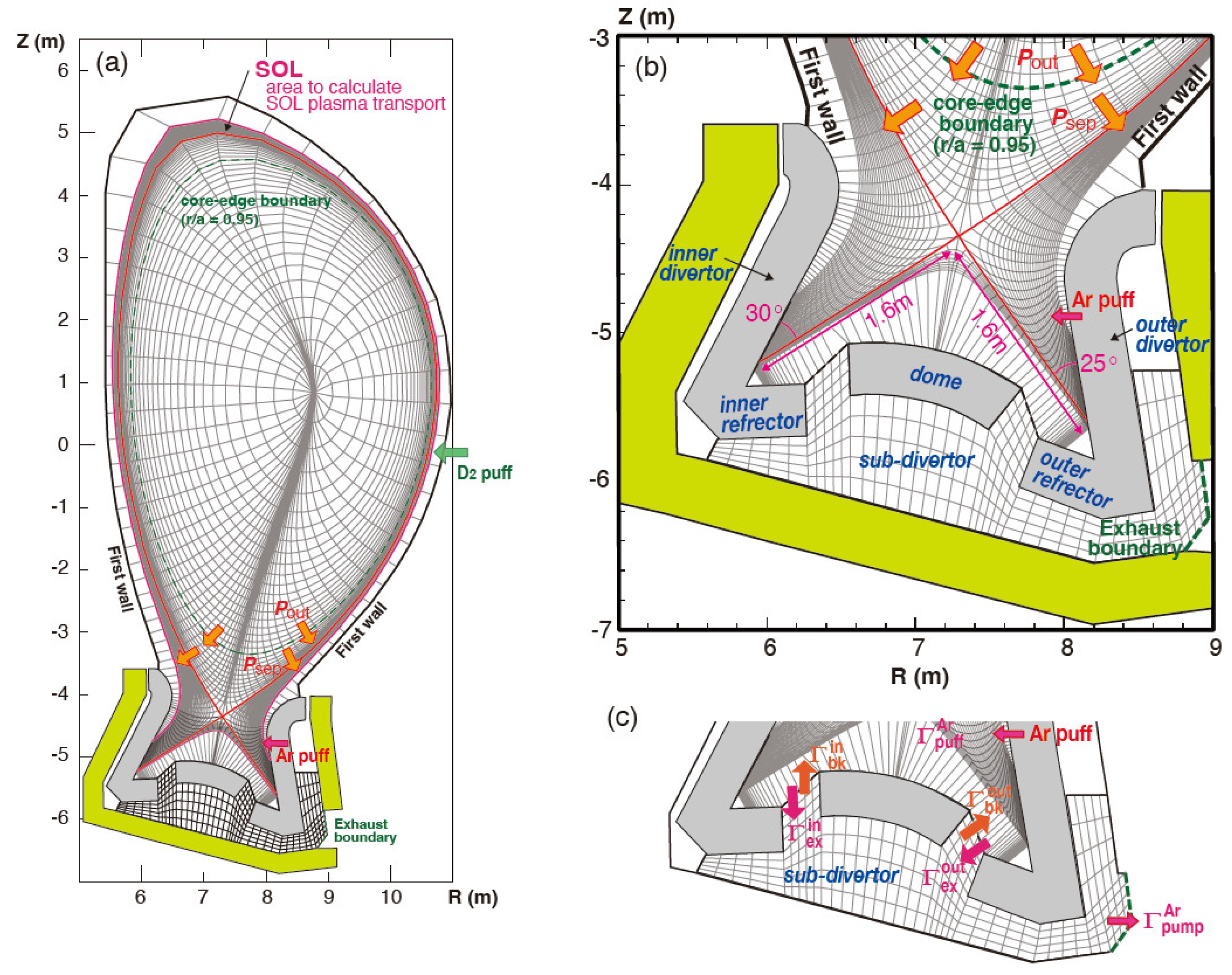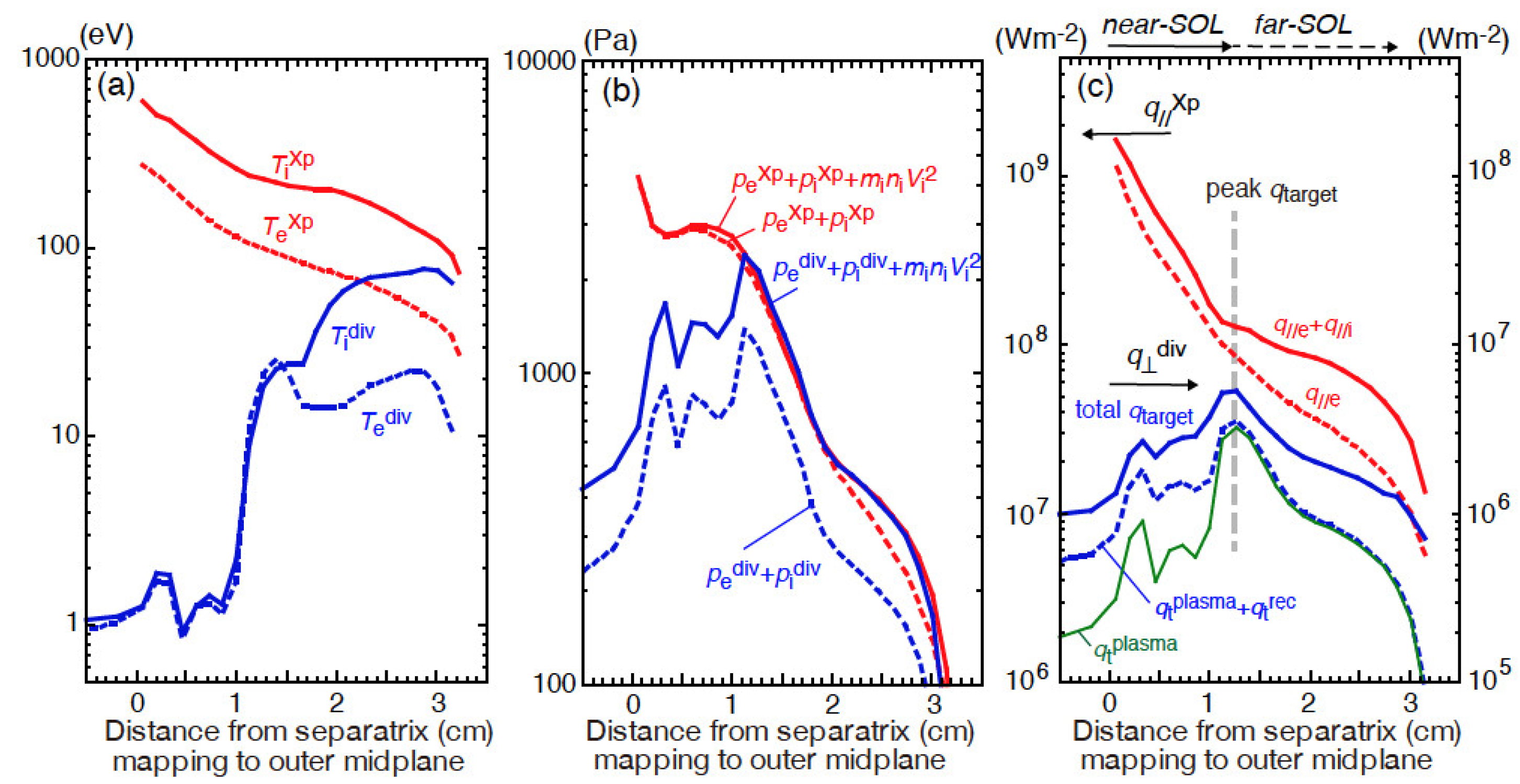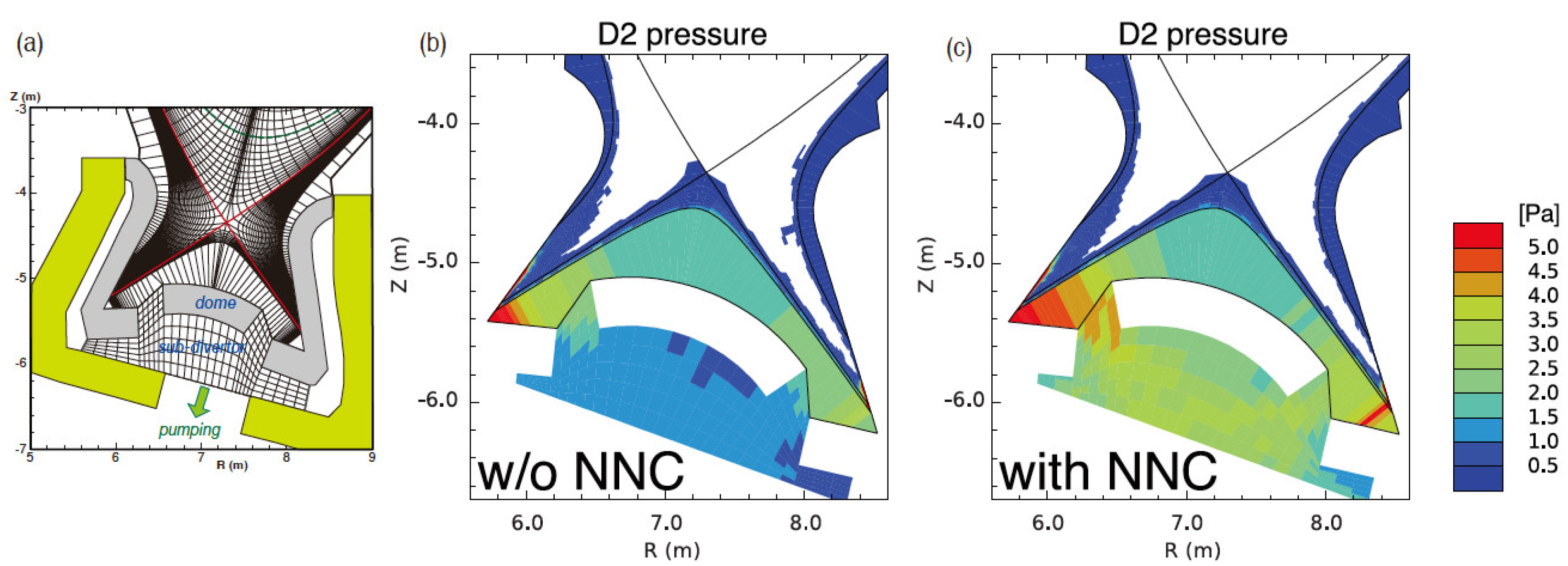Development and Application of SONIC Divertor Simulation Code to Power Exhaust Design of Japanese DEMO Divertor
Abstract
:1. Introduction: SONIC Code and Application to Japanese DEMO Designs
2. SONIC Development and Divertor Simulation for JA DEMO
2.1. Development of SONIC Framework
2.2. Divertor Simulation and Geometry for JA DEMO
2.3. MC Calculation Technique in Divertor
3. Divertor Design and Performance for Power Exhaust
3.1. Power Exhaust Scenario and Key Parameters
3.2. Radiation Loss and Plasma Detachment
3.3. Influence of Heat Flux Profile on Plasma Detachment
3.4. Divertor Operation in the Low Density SOL
4. Development of SONIC Modelings for DEMO Design
4.1. Improvement of Kinetic Model in Impurity Transport
4.2. Development of Photon Transport Model and Its Effect of Plasma Detachment
4.3. Neutral-Neutral Elastic Scattering Effect on Detachment and Neutral Pressure
5. Conclusions: Progress Summary
- Divertor design and reference operation scenarios for JA DEMO were determined
- Effect of SOL heat flux profile on the partial detachment in the divertor was clarified
- Operation boundary of JA DEMO divertor was clarified for key power exhaust parameters
- Physics models for divertor simulation were evaluated in DEMO SOL and divertor conditions
- (i)
- A kinetic model for the thermal force (TF) on impurity ions was evaluated for high temperature and low collisionality SOL plasma. The revised model affected to reduce both the TF on impurity transport and local accumulation peaks of cArdiv under the low collisionality SOL condition. It also reduced Pradsol, but the value was relatively small.
- (ii)
- Photon transport model showed that energy transport accompanying the photo-absorption/excitation significantly affected the evaluation of the heat load and the plasma profiles in the fully detached divertor under the DEMO-level high density condition (nediv ≥ a few 1021 m−3).
- (iii)
- The neutral–neutral collision (NNC) model was implicated since neutral–neutral elastic scattering plays an important role for distributions of neutrals and molecules, and detachment plasma. The preliminary result shows that neutral pressure in the sub-divertor region is increased by a factor of two to three, which significantly affects engineering design of the particle and He exhaust system.
Author Contributions
Funding
Data Availability Statement
Acknowledgments
Conflicts of Interest
References
- Shimizu, K.; Takizuka, T.; Sakurai, S.; Tamai, H.; Takenaga, H.; Kubo, H.; Miura, Y. Simulation of divertor detachment characteristics in JT-60 with superconducting coils. J. Nucl. Mater. 2003, 313, 1277–1281. [Google Scholar] [CrossRef]
- Kawashima, H.; Shimizu, K.; Takizuka, T.; Sakurai, S.; Nakano, T.; Asakura, N.; Ozeki, T. Development of Integrated SOL/Divertor Code and Simulation Study in JAEA. J. Plasma Fusion Res. 2006, 1, 31. [Google Scholar] [CrossRef] [Green Version]
- Braams, B. A Multi-Fluid Code for Simulation of the Edge Plasma in Tokamaks. NET Report EUR-FU IXII-80-87-68. Comm. of the European Communities. 1987. Available online: http://www.eirene.de/Braams-NET-report.pdf (accessed on 1 February 2022).
- Heifetz, D.B.; Post, D.; Petravic, M.; Wetsheit, J.; Bateman, G. A Monte-Carlo Model of Neutral-Particle Transport in Diverted Plasmas. J. Comp. Phys. 1982, 46, 309–327. [Google Scholar] [CrossRef] [Green Version]
- Heifetz, D.B. Physics of Plasma-Wall Interactions in Controlled Fusion; Post, D.E., Behrisch, R., Eds.; Plenum Press: New York, NY, USA; London, UK, 1986; p. 695. [Google Scholar]
- Shimizu, K.; Kubo, H.; Takizuka, T.; Azumi, M.; Shimada, M.; Tsuji, S.; Hosogane, N.; Sugie, T.; Sakasai, A.; Asakura, N.; et al. Impurity transport modelling and simulation analysis of impurity behavior in JT-60U. J. Nucl. Mater. 1995, 220, 410–414. [Google Scholar] [CrossRef]
- Shimizu, K.; Takizuka, T.; Sakasai, A. A review on impurity transport in divertors. J. Nucl. Mater. 1997, 241, 167–181. [Google Scholar] [CrossRef]
- Shimizu, K.; Takizuka, T.; Kawashima, H. Kinetic modelling of impurity transport in detached plasma for integrated divertor simulation with SONIC (SOLDOR/NEUT2D/IMPMC/EDDY). Nucl. Fusion 2009, 49, 065028. [Google Scholar] [CrossRef]
- Konoshima, S.; Tamai, H.; Miura, Y.; Higashijima, S.; Kubo, H.; Sakurai, S.; Shimizu, K.; Takizuka, T.; Koide, Y.; Hatae, T.; et al. Two-dimensional distribution of divertor radiation in JT-60U. J. Nucl. Mater. 2003, 313, 888–892. [Google Scholar] [CrossRef]
- Kawashima, H.; Shimizu, K.; Takizuka, T.; Sakurai, S.; Nakano, T.; Asakura, N.; Ozeki, T. Analysis of Particle Pumping Using SOLDOR/NEUT2D Code in the JT-60U Tokamak. Contrib. Plasma Phys. 2008, 48, 158–163. [Google Scholar] [CrossRef]
- Hoshino, K.; Shimizu, K.; Takizuka, T.; Asakura, N.; Nakano, T. Modelling of JT-60U Detached Divertor Plasma using SONIC code. J. Plasma Fusion Res. 2010, 9, 592–597. [Google Scholar]
- Hoshino, K.; Shimizu, K.; Takizuka, T.; Asakura, N.; Nakano, T. Improvement of the detachment modelling in the SONIC simulation. J. Nucl. Mater. 2011, 415, S549–S552. [Google Scholar] [CrossRef]
- Hoshino, K.; Shimizu, K.; Takizuka, T.; Asakura, N.; Nakano, T. The influence of the radial particle transport on the divertor plasma detachment. J. Nucl. Mater. 2015, 463, 573–576. [Google Scholar] [CrossRef]
- Asakura, N.; Kawashima, H.; Shimizu, K.; Sakurai, S.; Fujita, T.; Takenaga, H.; Nakano, T.; Kubo, H.; Higashijima, S.; Hayashi, T.; et al. Development of Integrated SOL/Divertor Code and Simulation Study in JAEA. In Proceedings of the 34th European Physical Society Conference Plasma Physics Controlled Fusion, Warsawa, Poland, 2–6 July 2007. [Google Scholar]
- Kawashima, H.; Shimizu, K.; Takizuka, T.; Asakura, N.; Sakurai, S.; Matsukawa, M.; Fujita, T. Design study of JT-60SA divertor for high heat and particle controllability. Fusion Eng. Des. 2008, 83, 1643–1647. [Google Scholar] [CrossRef]
- Shimizu, K.; Takizuka, T.; Kawashima, H. Kinetic effect of thermal force on impurity transport: Simulation of JT-60SA divertor with integrated divertor code SONIC. J. Nucl. Mater. 2009, 390, 307–310. [Google Scholar] [CrossRef]
- Kawashima, H.; Hoshino, K.; Shimizu, K.; Takizuka, T.; Ide, S.; Sakurai, S.; Asakura, N. Evaluation of heat and particle controllability on the JT-60SA divertor. J. Nucl. Mater. 2011, 415, S948–S951. [Google Scholar] [CrossRef]
- Hoshino, K.; Shimizu, K.; Kawashima, H.; Takizuka, T.; Nakano, T.; Ide, S. Development of the Backflow Model for Simplified Impurity Exhaust in Monte-Carlo Calculation. Contr. Plasma Phys. 2014, 54, 404–408. [Google Scholar] [CrossRef]
- Kawashima, H.; Shimizu, K.; Hoshino, K.; Nakano, T.; Asakura, N. Simulation of radiative divertor plasmas by Ar seeding with the full W-wall in JT-60SA. Contr. Plasma Phys. 2016, 56, 778–783. [Google Scholar] [CrossRef]
- Hoshino, K.; Homma, Y.; Tokunaga, S.; Shimizu, K. Multi-impurity divertor simulation using a Monte Carlo kinetic impurity transport model. Contr. Plasma Phys. 2018, 58, 638–642. [Google Scholar] [CrossRef]
- Yamoto, S.; Hoshino, K.; Homma, Y.; Nakano, T.; Hayashi, N. Simulation study of mixed-impurity seeding with extension of integrated divertor code SONIC. Plasma Phys. Control. Fusion 2020, 62, 045006. [Google Scholar] [CrossRef]
- Yamoto, S.; Hoshino, K.; Homma, Y.; Nakano, T.; Hayashi, N. Study of multiple impurity seeding effect using SONIC integrated divertor code for JT-60SA plasma prediction. Contr. Plasma Phys. 2020, 60, e201900146. [Google Scholar] [CrossRef]
- Groth, M.; Brezinsek, S.; Belo, P.; Beurskens, M.N.A.; Brix, M.; Clever, M.; Coenen, J.W.; Corrigan, C.; Eich, T.; Flanagan, J.; et al. Impact of carbon and tungsten as divertor materials on the scrape-off layer conditions in JET. Nucl. Fusion 2013, 53, 093016. [Google Scholar] [CrossRef]
- Pitts, R.A.; Bonnin, X.; Escourbiac, F.; Frerichs, H.; Gunn, J.P.; Hirai, T.; Kukushkin, A.S.; Kaveeva, E.; Miller, M.A.; Moulton, D.; et al. Physics basis for the first ITER tungsten divertor. Nucl. Meter. Energy 2019, 20, 100696. [Google Scholar] [CrossRef]
- Kaveeva, E.; Rozhansky, V.; Senichenkov, I.; Sytova, E.; Veselova, I.; Voskoboynikov, S.; Bonnin, X.; Pitts, R.A.; Kukushkin, A.S.; Wiesen, S.; et al. SOLPS-ITER modelling of ITER edge plasma with drifts and currents. Nucl. Fusion 2020, 60, 046019. [Google Scholar] [CrossRef]
- Coster, D.P.; Bonnin, X.; Braams, B.; Buerbaumer, H.; Kaveeva, E.; Kim, J.-W.; Kukushkin, A.; Nishimura, Y.; Reiter, D.; Rozhansky, V.; et al. Further Developments of the Edge Transport Simulation Package, SOLPS. In Proceedings of the 19th International Conference on Fusion Energy, Lyon, France, 14–19 October 2002. [Google Scholar]
- Tobita, K.; Nishio, S.; Enoeda, M.; Kawashima, H.; Kurita, G.; Tanigawa, H.; Nakamura, H.; Honda, M.; Saito, A.; Sato, S.; et al. Compact DEMO, SlimCS: Design progress and issues. Nucl. Fusion 2009, 49, 075029. [Google Scholar] [CrossRef]
- Asakura, N.; Shimizu, K.; Hoshino, K.; Tobita, K.; Tokunaga, S.; Takizuka, T. A simulation study of large power handling in the divertor for a Demo reactor. Nucl. Fusion 2013, 53, 123013. [Google Scholar] [CrossRef]
- Sakamoto, Y.; Tobita, K.; Utoh, H.; Asakura, N.; Someya, Y.; Hoshino, K.; Nakamura, M.; Tokunaga, S.; the DEMO Design Team. DEMO Concept Development and Assessment of Relevant Technologies. In Proceedings of the 25th IAEA International Conference on Fusion Energy, St. Petersburg, Russia, 13–18 October 2014. [Google Scholar]
- Tobita, K.; Asakura, N.; Hiwatari, R.; Someya, Y.; Utoh, H.; Katayam, K.; Nishimura, A.; Sakamoto, Y.; Homma, Y.; Kudo, H.; et al. Design Strategy and Recent Design Activity on Japan’s DEMO. Fusion Sci. Technol. 2017, 72, 537–545. [Google Scholar] [CrossRef]
- Asakura, N.; Hoshino, K.; Suzuki, S.; Tokunaga, S.; Someya, Y.; Utoh, H.; Kudo, H.; Sakamoto, Y.; Hiwatari, R.; Tobita, K.; et al. Studies of power exhaust and divertor design for a 1.5 GW-level fusion power DEMO. Nucl. Fusion 2017, 57, 126050. [Google Scholar] [CrossRef]
- Wenninger, R.; Arbeiter, F.; Aubert, J.; Aho-Mantila, L.; Albanese, R.; Ambrosino, R.; Angioni, C.; Artaud, J.-F.; Bernert, M.; Fable, E.; et al. Advances in the physics basis for the European DEMO design. Nucl. Fusion 2015, 55, 063003. [Google Scholar] [CrossRef]
- ITER Physics Basis Expert Groups on Confinement and Transport and Confinement Modelling and Database, ITER Physics Basis Editor. Nucl. Fusion 1999, 39, 2175–2250.
- Kawashima, H.; Shimizu, K.; Takizuka, T.; Tobita, K.; Nishio, S.; Sakurai, S.; Takenaga, H. Simulation study for divertor design to handle huge exhaust power in the SlimCS DEMO reactor. Nucl. Fusion 2009, 49, 065007. [Google Scholar] [CrossRef]
- Asakura, N.; Shimizu, K.; Kawashima, H.; Tobita, K.; Takizuka, T. Simulation of Power Exhaust in Edge and Divertor of the SlimCS Tokamak Demo Reactor. J. Plasma Fusion Res. Ser. 2010, 9, 136–141. [Google Scholar]
- Hoshino, K.; Shimizu, K.; Asakura, N.; Takizuka, T.; Nakamura, M.; Tobita, K. Simulation Study of an Extended Divertor Leg for Heat Control in the SlimCS DEMO Reactor. Contrib. Plasma Phys. 2012, 52, 550–554. [Google Scholar] [CrossRef]
- Hoshino, K.; Asakura, N.; Shimizu, K.K.; Tokunaga, S.; Takizuka, T.; Someya, Y.; Nakamura, M.; Utoh, H.; Sakamoto, Y.; Tobita, K. Divertor Study on DEMO Reactor. Plasma Fusion Res. 2014, 9, 3403070. [Google Scholar] [CrossRef]
- Asakura, N.; Hoshino, K.; Homma, Y.; Sakamoto, Y. Joint Special Design Team for Fusion DEMO Simulation studies of divertor detachment and critical power exhaust parameters for Japanese DEMO design. Nucl. Mater. Energy 2021, 26, 100864. [Google Scholar] [CrossRef]
- Kukushkin, A.; Pacher, H.D.; Pacher, G.W.; Kotov, V.; Pitts, R.A.; Reiter, D. Consequences of a reduction of the upstream power SOL width in ITER. J. Nucl. Mater. 2013, 438, S203–S207. [Google Scholar] [CrossRef]
- Loarte, A.; Lipschultz, B.; Kukushkin, A.S.; Matthews, G.F.; Stangeby, P.C.; Asakura, N.; Counsell, G.F.; Federici, G.; Kallenbach, A.; Krieger, K.; et al. Progress in the ITER Physics Basis Chapter 4: Power and particle control. Nucl. Fusion 2007, 47, S203–S263. [Google Scholar] [CrossRef] [Green Version]
- Subba, F.; Coster, D.P.; Moscheni, M.; Siccinio, M. SOLPS-ITER modeling of divertor scenarios for EU-DEMO. Nucl. Fusion 2021, 61, 106013. [Google Scholar] [CrossRef]
- Asakura, N.; Hoshino, K.; Kakudate, S.; Subba, F.; Vorpahl, C.; Homma, Y.; Utoh, H.; Someya, Y.; Sakamoto, Y.; Hiwatari, R.; et al. Power Exhaust Concepts and Divertor Designs for Japanese and European DEMO Fusion Reactors. Nucl. Fusion 2021, 61, 126057. [Google Scholar] [CrossRef]
- Kallenbach, A.; Asakura, N.; Kirk, A.; Korotkov, A.; Mahdavi, M.A.; Mossessian, D.; Porter, G.D. Multi-machine comparisons of H-mode separatrix densities and edge profile behaviour in the ITPA SOL and Divertor Physics Topical Group. J. Nucl. Mater. 2005, 337, 381–385. [Google Scholar] [CrossRef]
- Leonard, A.W.; McLean, A.G.; Makowski, M.A.; Stangeby, P.C. Compatibility of separatrix density scaling for divertor detachment with H-mode pedestal operation in DIII-D. Nucl. Fusion 2017, 57, 086033. [Google Scholar] [CrossRef]
- Eich, T.; Goldston, R.J.; Kallenbach, A.; Sieglin, B.; Sun, H.J. ASDEX Upgrade Team; JET Contributors; Correlation of the tokamak H-mode density limit with ballooning stability at the separatrix. Nucl. Fusion 2018, 58, 034001. [Google Scholar] [CrossRef] [Green Version]
- Krasheninnikov, S.I. Reverse flow and parameter profiles in a dense tokamak divertor plasma. Nucl. Fusion 1992, 32, 1927–1934. [Google Scholar] [CrossRef]
- Eich, T.; Leonard, A.W.; Pitts, R.A.; Fundamenski, W.; Goldston, R.J.; Gray, T.K.; Herrmann, A.; Kirk, A.; Kallenbach, A. Scaling of the tokamak near the scrape-off layer H-mode power width and implications for ITER. Nucl. Fusion 2013, 53, 093031. [Google Scholar] [CrossRef]
- Reiser, D.; Reiter, D.; Tokar, M.Z. Improved kinetic test particle model for impurity transport in tokamaks. Nucl. Fusion 1998, 38, 165–177. [Google Scholar] [CrossRef]
- Homma, Y.; Hoshino, K.; Tokunaga, S.; Yamoto, S.; Hatayama, A.; Asakura, N.; Sakamoto, Y.; Tobita, K. Joint Special Design Team for Fusion DEMO An extended kinetic model for the thermal force on impurity particles in weakly collisional plasmas. Contrib. Plasma Phys. 2018, 58, 629–637. [Google Scholar] [CrossRef]
- Homma, Y.; Hoshino, K.; Yamoto, S.; Tokunaga, S.; Asakura, N.; Sakamoto, Y. Joint Special Design Team for Fusion DEMO Effect of collisionality dependence of thermal force on impurity transport under a lower collisional condition in DEMO scrape-off layer plasma. Nucl. Fusion 2020, 60, 046031. [Google Scholar] [CrossRef]
- Sawada, K. Iterative numerical method for the inclusion of radiation trapping into a collisional-radiative model. J. Plasma Phys. 2006, 72, 1025–1029. [Google Scholar] [CrossRef]
- Hoshino, K.; Sawada, K.; Idei, R.; Tokunaga, S.; Asakura, N.; Shimizu, K.; Ohno, N. Photon Trapping Effects in DEMO Divertor Plasma. Contrib. Plasma Phys. 2016, 56, 657–662. [Google Scholar] [CrossRef]
- Krstic, P.; Schultz, D. Elastic and Related Transport Cross Sections for Collisions among Isotopomers of H++H, H++H2, H++He, H+H, and H+H2. At. Plasma-Mater. Data Fusion 1998, 8, 1–689. [Google Scholar]
- Phelps, A.V. Cross Sections and Swarm Coefficients for H+, H2+, H3+, H, H2, and H− in H2 for Energies from 0.1 eV to 10 keV. J. Phys. Chem. Ref. Data 1990, 19, 653. [Google Scholar] [CrossRef] [Green Version]
- Reiter, D.; May, C.; Baelmans, M.; Börner, P. Non-linear effects on neutral gas transport in divertors. J. Nucl. Mater. 1997, 241, 342–348. [Google Scholar] [CrossRef]










Publisher’s Note: MDPI stays neutral with regard to jurisdictional claims in published maps and institutional affiliations. |
© 2022 by the authors. Licensee MDPI, Basel, Switzerland. This article is an open access article distributed under the terms and conditions of the Creative Commons Attribution (CC BY) license (https://creativecommons.org/licenses/by/4.0/).
Share and Cite
Asakura, N.; Hoshino, K.; Homma, Y.; Sakamoto, Y.; Joint Special Design Team for Fusion DEMO. Development and Application of SONIC Divertor Simulation Code to Power Exhaust Design of Japanese DEMO Divertor. Processes 2022, 10, 872. https://doi.org/10.3390/pr10050872
Asakura N, Hoshino K, Homma Y, Sakamoto Y, Joint Special Design Team for Fusion DEMO. Development and Application of SONIC Divertor Simulation Code to Power Exhaust Design of Japanese DEMO Divertor. Processes. 2022; 10(5):872. https://doi.org/10.3390/pr10050872
Chicago/Turabian StyleAsakura, Nobuyuki, Kazuo Hoshino, Yuki Homma, Yoshiteru Sakamoto, and Joint Special Design Team for Fusion DEMO. 2022. "Development and Application of SONIC Divertor Simulation Code to Power Exhaust Design of Japanese DEMO Divertor" Processes 10, no. 5: 872. https://doi.org/10.3390/pr10050872
APA StyleAsakura, N., Hoshino, K., Homma, Y., Sakamoto, Y., & Joint Special Design Team for Fusion DEMO. (2022). Development and Application of SONIC Divertor Simulation Code to Power Exhaust Design of Japanese DEMO Divertor. Processes, 10(5), 872. https://doi.org/10.3390/pr10050872





